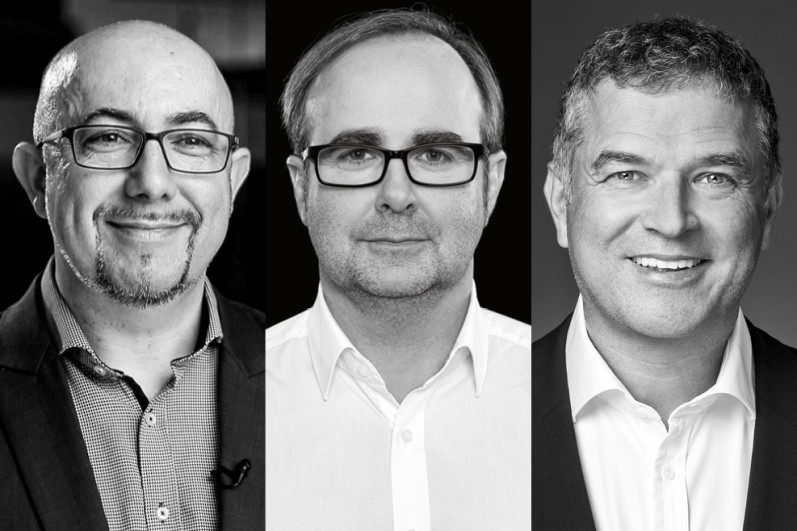Page content
NEWS-Blog

Goldpartner-Interview: Made by professionals for professionals: digital networking as an overall strategy
March 6th, 2020 – Creating a digitally networked healthcare system cannot be achieved by a single provider, but is a project that must involve all service providers and in particular the patient. CGM Clinical Deutschland offers a wide range of IT solutions for virtually every kind of healthcare professional and achieves integration in a wide range of scenarios. Managing director Thomas Simon, general manager Clinic Operations Andreas Waldbrenner and head of brand communication Michael Franz set out their vision for DMEA 2020.
CGM has recently been in the news again with takeovers.You are at the forefront of the telematics infrastructure and are heavily involved in hospital IT.What is your overall vision?
Simon: The common thread linking all CGM activities is intersectoral networking. If we can realise this efficiently with digital technology, in terms of quality it will be a major step forward in medical care and thus for the patient. We believe the best way to achieve this is if a company has in-depth knowledge of the various markets. That is why we are targeting every aspect of care. Visitors to our stand at DMEA 2020 can find out about practically everything to do with digitalisation of the healthcare system.
How do the two latest takeovers fit in with this overall plan?
Simon: The takeovers are a good illustration of this point. The French company Epsilog specialises in physiotherapy and outpatient nursing and is a domestic market leader. This market is very important for outpatient nursing care which is why, in the context of digitalisation, it cannot be ignored. The second takeover concerns H&S, an Italian IT provider with a focus on telemedicine and home nursing care. Here again, nursing care is a major aspect of the intersectoral care market. We are also looking at ambient assisted living, as H&S focuses strongly on sensor technology and case recognition etc. That takes us directly part to our display at DMEA: H&S will be represented with a product on the stand.
Clinic operations are traditionally a key topic at DMEA. What can exhibitors expect here?
Waldbrenner: we are exhibiting a whole range of new or significantly redesigned tools for the hospital market which form part of our core product CGM CLINICAL, in two versions – CGM AKUT for emergency clinics and CGM REHA for rehab clinics. I would like to highlight OP Management for emergency clinic use here. We have expanded its range of functions and are now able to mirror the entire process from registration to surgery reports. One of our strengths is the ability to integrate the entire clinical process. For example, we can communicate with the Aescudata materials management systems CGM AMOR and CGM MUSE. That is a huge advantage for clinics and substantially improves efficiency. We have also significantly expanded our multi-resource planning, which takes every hospital resource into account – workers, rooms, equipment and material. This permits planning of complex tasks, offers a high degree of planning certainty, and a rules-based treatment plan over longer periods of time for instance.
What about basic processes in clinics? What progress is being made there?
The nursing care and medication processes of CGM CLINICAL have been significantly expanded too. The same thing applies here: its big asset is seamless integration in other clinical processes. We do not have solitary modules of the kind sometimes seen in specialist systems, but offer genuine integration which unleashes vast synergies and takes the strain off workers while improving efficiency. In terms of functions, CGM CLINICAL has everything that is required of a modern HIS. Nursing care functions include mobile medication support for instance, vital patient data and documentation of sores. Medication features include medication history and medical reports, in which context I would like to highlight the digital patient timeline which allows medication entries and which can be configured in great detail. Like all new CGM CLINICAL modules, the patient timeline is based on our semantic data model which assigns an unambiguous definition and unit to every clinical parameter. This makes it easier to evaluate and represent.
If you ask experts then connecting with the telematics infrastructure (TI) will be among the big topics as far as hospitals are concerned in 2020? Will that also be the case on your stand at DMEA?
Franz: Where else? We will be bringing our highly scalable Connector Farm along which any hospital of any size can use to connect to the TI. In April the Connector Farm will feature eHealth connectors, i.e. the latest connector generation which we are trialling in Westfalen-Lippe during the first quarter of 2020. With this new connector generation hospitals can make use of electronic emergency data, an electronic medication plan and gematik applications for communicating with health insurances, which the TI will make available soon.
Emergency data and medication plan – cue the patient. Assuming a patient comes to your stand at DMEAwhat will you show them?
Franz: We very much hope to see patients on our stand too. We will show them CGM LIFE, our patient file solution which is now much more than just an ultra-secure data storage device. At DMEA we are exhibiting our Click Doc platform which is based on CGM LIFE, a comprehensive communication solutions which places citizens/patients on the same level and provides access to a whole range of partner apps. Click Doc searches for and makes appointments and handles surgery appointments via videolink. In the long-term one can imagine domestic telemonitoring applications, all functioning on the ultra-secure CGM LIFE platform. This, by the way, is where we come back to the takeover of H&S, as mentioned at the beginning. Digitalising the healthcare system cannot be achieved piecemeal. One has to look at the bigger picture – including the patient.


